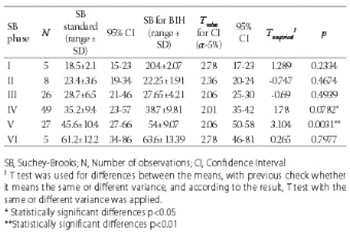Morphological characteristics of pubic symphysis for age estimation of exhumed persons
DOI:
https://doi.org/10.17305/bjbms.2012.2534Keywords:
pubic symphysis, age estimation, Suchey-Brooks method, identification, population of Bosnia and HerzegovinaAbstract
Suchey-Brooks method based on morphological features of pubic symphysis is a common method of age evaluation of human skeletal remains. The aim of the study was the classification of the examined samples into a particular phase according to Suchey-Brooks method, comparing the estimated age according to Suchey-Brooks with living age of the identified persons. The study was conducted on 120 pairs of pubic bones symphysis of male who disappeared from the area of north-west Bosnia during previous war, who were exhumed and the process of their identification was previously finished. The youngest person was 19 years old and the oldest 86. The study was retrospective, made by comparing the morphological characteristics of pubic symphysis pairs of the examined sample with Suchey-Brooks standards. The statistical analysis of data obtained by the survey showed that the smallest deviations from the average were in phase II by Suchey-Brooks, while the maximum deviation was in phase IV. The standard deviation generally increases from phase to phase, which is to be expected. The span of age obtained for Bosnian population is smaller at all stages in relation to Suchey Brooks-standards, as well as standard deviation, except in phases IV and VI. There was a significant difference noticed in phase V in the estimation of age between the original method and Bosnian population. In general, Suchey-Brooks method leads to underestimation of age, but the underestimation or overestimation in relation to the actual age is possible at each stage, which indicates the individual biological variation.
Citations
Downloads

Downloads
Additional Files
Published
Issue
Section
Categories
How to Cite
Accepted 2017-10-04
Published 2012-02-20









